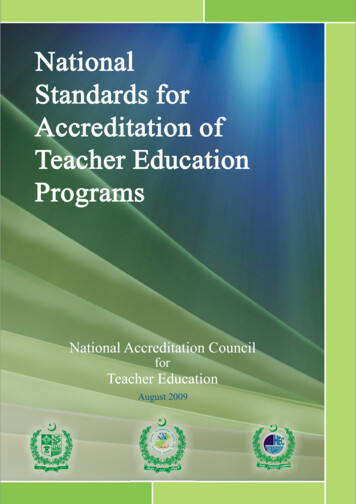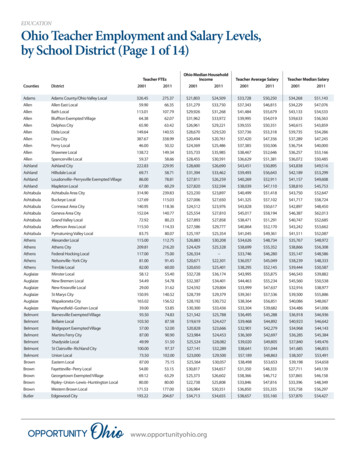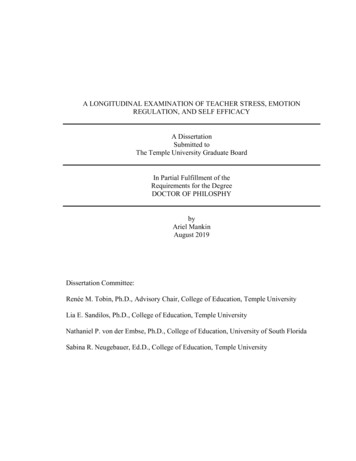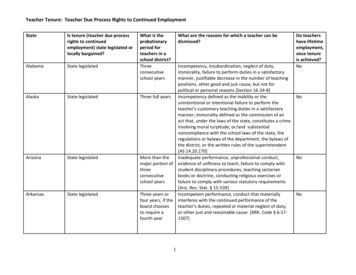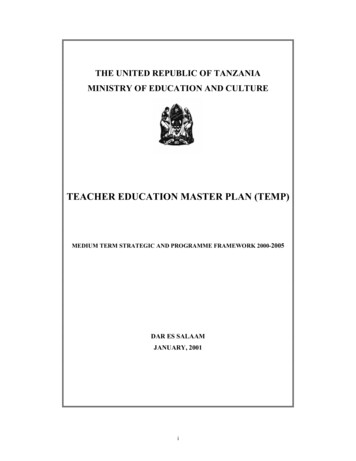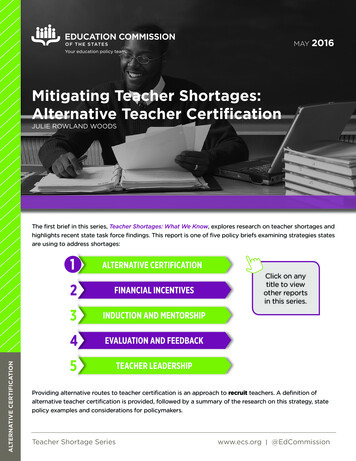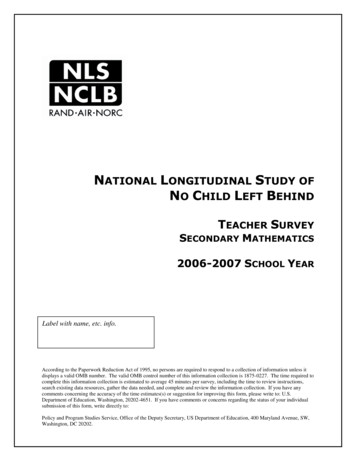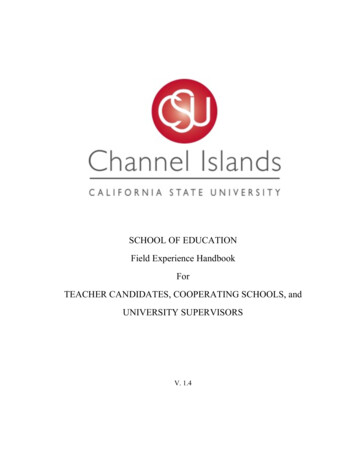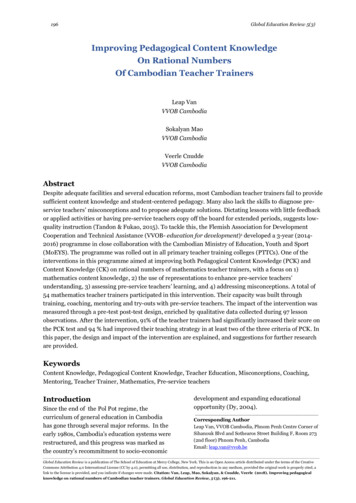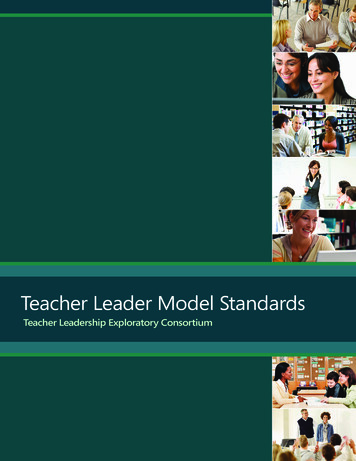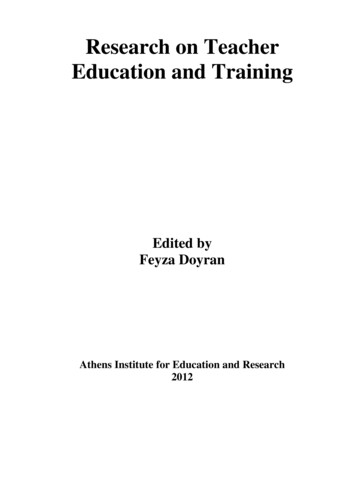
Transcription
Research on TeacherEducation and TrainingEdited byFeyza DoyranAthens Institute for Education and Research20121
Board of ReviewersGary E. Bingham, Assistant ProfessorGeorgia State University, USAChinaka DomNwachukwu, Associate Dean and ProfessorAzusa Pasific University, USAMichael Grimley, Associate ProfessorUniversity of Canterbury, New ZealandJohn E. Kesner, Associate ProfessorGeorgia State University, USAAlexander Makedon, Head, Education Research Unit, ATINER & Professor,College of Education, Chicago State University, USAKimberley F. Nettleton, InstructorMorehead State University, USAStelios Orphanos, LecturerFrederick University, CyprusSue Wilson, LecturerUniversity of Canterbury, New Zealand2
Research on TeacherEducation and TrainingEdited byFeyza DoyranAthens Institute for Education and Research20123
First Published in Athens, Greece by theAthens Institute for Education and Research.ISBN: 978-960-9549-74-5All rights reserved. No part of this publication may be reproduced, stored, retrievedsystem, or transmitted, in any form or by any means, without the written permissionof the publisher, nor ne otherwise circulated in any form of binding or cover.Printed and bound in Athens, Greece by ATINER8 Valaoritou Street, Kolonaki10671 Athens, Greecewww.atiner.gr Copyright 2012 by the Athens Institute for Education and Research.The individual essays remain the intellectual properties of the contributors.4
Research on TeacherEducation and Training5
6
Table of Contents1.2.3.4.5.6.7.8.9.10.11.12.13.14.Research on Teacher Education and Training:An IntroductionFeyza DoyranPart I: Improving Teacher Education and TrainingJob Satisfaction among Faculty: Does Gender Play a Role?Parveen AliChildhood Government and Scholar Education.The Emergence of New Student and Teacher IdentitiesFátima PereiraInstructor and Student Perceptions of Mathematics forTeachers CoursesLynn C. Hart, Susan Oesterle and Susan SwarsA Cross-Cultural Investigation into Gender Issues for MaleTeachers in Primary SchoolsPenni CushmanExploring Preserves Early Childhood Education Teachers’Views on Science, Technology and Society IssuesEbru Ersay CekmeceliogluA Reflection on the Development and Use of ExemplificationMaterials and Descriptors to Embed the 2007 Revised Standardsfor Qualified Teacher Status (QTS) for England and toChallenge Trainee Teachers to go beyond ‘Satisfactory’Kevin Mattinson and Andrew ConnellAnalysis of Factors Affecting Pre Service Biology Teachers’Teacher Efficacy BeliefsGulay Ekici, Pinar Fettahlioglu and Ayse Sert CibikDesign and Research on Interactive Whiteboard basedTeaching Reflection DSTYan Yan, Zhao Guo and Yang HuiLike the Phoenix, We Will Rise Again:Improving Preparation of Novice TeachersBrenda E. LoganDo Visual Frameworks for Professional Reflection on Planningand Lesson Delivery Impact the Range of Reflections?Nancy Maynes and Lynn Julien-SchultzPart II: Improving Teaching and Learning in SchoolsAddressing Diversity:What Do We Really Know about Differentiated Instruction?Brenda E. LoganThe Effects of Social Class on Primary School Children’sExperiences of Extra-Curricular Activities and how theyspend their Free TimeLaura McClintockProblem Solving in Integrated Curriculum: The Results of anAction Research ProjectJasmina Milinković113273749617187991091191351471657
15. Coping with Behavioural Difficulties in the Irish PrimarySchool Classroom: An Investigation of Teachers’ ExperiencesLynda Hyland, Sinéad McGilloway and Anne Lodge16. Increasing Opportunities for Career Education andExploration for Students in Grades 1-12Mark W. Slomp, Kerry B. Bernes and Lana M. Caldwell17. Determination of the Relationship between the Samples ofInstructional Methods and Techniques Prepared for 4thGrade Elementary School Science and Technology Curriculaand the Principles of Neuropsychological Theory in TurkeyMetin Ascı and Fatma Sasmaz Oren18. Museum Education in Turkey:A Step Closer to Children’s MuseumCeren Karadeniz19. Using K-W-L Chart as an Alternative Assessment Tool inScience LaboratoryBaris Eroglu and Sedef Canbazoglu Bilici20. Socialization Values across EuropeNada TurnšekPart III: Improving Teaching and Learning in Higher Education21. Acquiring Vocabulary at the University Level:A Comparison of Three Learning StrategiesYaacov J. Katz and Yaacov B. Yablon22. Academic Performance in Public Higher EducationInstitutions: A Study on the Effects of Teacher Commitment,Teaching Methodologies and Evaluation Methodologies inStudents attending Nursing and Management CoursesIsabel Fialho, José Saragoça, Hugo Rebelo, Marília Cid,Manuela Oliveira, Jorge Bonito, Adelinda Candeiasand Vitor Trindade23. Inter-Subject Commonality of Cognitive and LinguisticFactors Relative to Learning Difficulties of College Studentsand its Implications for an Intervention ProgramSachiko Asano24. Through what Interactive Structures Teachers and Studentsrelate to University Classrooms?Mar Prados and Mercedes Cubero25. Measuring Perceived Learning in Higher EducationMervyn J. Wighting and M. Gail Derrick26. Changing Pedagogy into Scholarship: Teaching and Learningin Higher EducationCarol G. Walker, Carol Todd and Karen A. Hahn27. The Problem of Inconsistency in Reasoning in EngineeringEducation – A Case Study about the Mental Model of SoundArcadi Pejuan, Xavier Bohigas, Xavier Jaén andCristina Periago8177189217229241249267277291303315323331
List of ContributorsParveen Ali, Assistant Professor, Indiana University of Pennsylvania, USASachiko Asano, Professor, Osaka University of Health and Sport Sciences,JapanKerry B. Bernes, Associate Profesor, The University of Lethbridge, CanadaSedef Canbazoglu Bilici, Research Assistant, Aksaray University, TurkeyXavier Bohigas, Lecturer, Technical University of Catalonia, SpainJorge Bonito, Auxiliary Professor, University of Évora, PortugalLana M. Caldwell, Graduate Assistant, The University of Lethbridge, CanadaAdelinda Candeias, Auxiliary Professor, University of Évora, PortugalEbru Ersay Cekmecelioglu, Instructor, Gazi University, TurkeyAyse Sert Cibik, Research Assistant, Gazi University, TurkeyMarília Cid, Auxiliary Professor, University of Évora, PortugalAndrew Connell, PGCE ICT Course Leader and ICT DevelopmentCoordinator, Keele University, UKMercedes Cubero, Associate Professor, University of Seville, SpainPenni Cushman, Senior Lecturer, University of Canterbury, New ZelandZhao Guo Dong, Associate Professor, Peking University, P.R. ChinaFeyza Doyran, Assistant Professor, Bahçeşehir University, TurkeyM. Gail Derrick, Professor, Regent University, USAGulay Ekici, Associate Professor, Gazi University, TurkeyBaris Eroglu, Research Assistant, Aksaray University, TurkeyPinar Fettahlioglu, Research Assistant, Gazi University, TurkeyIsabel Fialho, Auxiliary Professor, University of Évora, PortugalKaren A. Hahn, Director of Graduate Studies in Education, Saint LeoUniversity, USALynn C. Hart, Professor, Georgia State University, USAYang Hui, Associate Professor, Capital Normal University, P.R. ChinaLynda Hyland, Doctoral Fellow, National University of Ireland, Maynooth,IrelandXavier Jaén, Lecturer, Technical University of Catalonia, SpainCeren Karadeniz, Research Assistant, Ankara University, TurkeyYaacov J. Katz, Professor, Bar-Ilan University, IsraelAnne Lodge, Principal, Church of Ireland College of Education, IrelandBrenda E. Logan, Associate Professor, Armstrong Atlantic State University,USAKevin Mattinson, Director of Initial Teacher Education, Keele University, UKNancy Maynes, Assistant Professor, Nipissing University, CanadaLaura McClintock, Senior Lecturer, London South Bank University, UKSinéad McGilloway, Senior Lecturer, National University of Ireland,Maynooth, IrelandJasmina Milinković, Associate Professor, University of Belgrade, SerbiaSusan Oesterle, Doctoral Student, Simon Fraser University, CanadaManuela Oliveira, Auxiliary Professor, University of Évora, Portugal9
Arcadi Pejuan, Lecturer, Technical University of Catalonia, SpainFátima Pereira, Professor, University of Porto, PortugalCristina Periago, Lecturer, Technical University of Catalonia, SpainMar Prados, Researcher, University of Seville, SpainHugo Rebelo, Researcher, University of Évora, PortugalLynn Julien-Schultz, Professor, Nipissing University, CanadaJosé Saragoça, Assistant Professor, University of Évora, PortugalMark W. Slomp, Counsellor, The University of Lethbridge, CanadaSusan Swars, Associate Professor, Georgia State University, USACarol Todd, Assistant Professor, Saint Leo University, USAVitor Trindade, Researcher, University of Évora, PortugalNada Turnšek, Assistant Professor, University of Ljubljana, SloveniaCarol G. Walker, Dean of the School of Education and Social Services, SaintLeo University, USAMervyn J. Wighting, Professor, Regent University, USAYaacov B. Yablon, Professor, Bar-Ilan University, IsraelYan Yan, Postgraduate, Peking University, P.R. China10
Research on Teacher Education and Training: An Introduction111Research on Teacher Education andTraining: An IntroductionFeyza Doyran, Bahcesehir University, TurkeyOne of the most important concerns all over the World is no doubt“Education.” No matter who we are, or what profession we perform, we havethings to say about this important issue. We criticize the existing educationalsystem in the countries we live in, comment on the new systems around theworld or suggest new ways of teaching and learning. The impact of educationis unquestionable, but another important concern is related to the teachers inthese educational systems. The impact of any educational system can only beas powerful and effective as the teachers or the educational leaders whoactually perform this profession. The lives of all learners are shaped by theteachers. A teacher can easily become an educational leader; can createpositive change in the classroom and in the lives of his/her students and canshape the environment, or even the future of the country. On the other hand, ateacher can also ruin the lives of individuals. How should these role models beeducated and trained then? This has long been debated and no perfect answerwas found to solve this argument. Even if there are good programs or curriculato prepare future teachers, there is always room for improvement.Teachers and schools need to keep up with the recent developments in thefield of teacher education and training in order to be able to improve theirprograms and the quality of teaching and learning process. In order to supportthis, we need to look at the recent research conducted in the field.The main purpose of this book is to highlight some of the recent studiesconducted in the area of teacher education and training with its practicalapplications and implications in the teaching and learning process. There arethree parts in the book. Part I includes articles related to research on improvingteacher education and training. In this part, there are ten research papers. Thesecond part covers research on improving teaching and learning in schools,which covers nine papers and the third part with seven papers center aroundresearch on improving teaching and learning in higher education. In thefollowing paragraphs, the research articles included in these parts are brieflydescribed.1
Research on Teacher Education and TrainingThe first paper in part one discusses the job satisfaction characteristics ofhigher education faculty in U.S. colleges and universities by gender at anational level. The author of this study, Parveen Ali, utilizes secondary datacoming from the National Center of Education Statistics. The results suggestthat intrinsic as well as extrinsic job satisfaction variables have a significanteffect on faculty members’ job satisfaction and significant gender differencesexist with respect to most of the variables selected. Moreover, achievement,satisfaction with work itself, satisfaction with salary, institutional policy,institutional environment, and peer relationships are found to be the mostinfluential predictors of faculty members’ overall job satisfaction. Underrepresentation of female faculty in higher education is one of the pressingissues facing the new millennium.The second research by Pereira analyses discourses about childhoodexpressed in initial teacher education curriculum and in biographical narrativesof primary school teachers. The study considers that the school institution isthe one that is most involved in intention to transform subjectivities andsociability that modernity has tried to bring about and which choose childhoodas the prime subject of its intervention. It considers also that school institutionis today a social place of tensions and conflicts that forces teachers to make aconstant effort to produce and to justify their work. All of which interferes withthe relation that teachers develop with children, with the ethical dimension ofschool education and with the way children live their relation with schooling.Childhood government is related with the everyday life in school and is part ofthe conditions that contributes to the identities’ construction in school. Thestudy reveals that the childhood government in scholar education isdestabilized and more conditioned by teachers’ ethics on ideology and bycontextualized justifications and types of justice than by legitimizedinstitutional social mandates.The research article by Hart, Oesterle and Swars draws on the results fromtwo qualitative studies. In the first study, eight instructors from seveninstitutions in south-western Canada were interviewed about their perceptionsand approaches in teaching Math for Teachers (MFT) courses for elementaryprospective teachers (Oesterle&Liljedahl, 2009). The second study involvedinterviews of twelve students from a university in the south-eastern UnitedStates who had completed MFT courses required in their elementary educationprogram (Hart & Swars, 2009). Two themes emerge at the end of the initial andsecondary analysis which resonate across both studies: the importance ofconnections to the elementary classroom and the role of affect in studentlearning. The report elaborates on these themes and discusses possibleimplications for teacher learning.The worldwide shortage of male teachers in primary schools has produced avariety of strategies designed to increase their numbers. Commentators justifythe need for more male teachers in primary schools in terms of their presumedability to provide students with male role models, to inspire and engage boys intheir learning and contribute to a better balance of male and female teachers.There are cultural variations in the reasons men choose not to teach, but one2
Research on Teacher Education and Training: An Introductioncommon theme in a number of countries has been a fear of being accused ofsexual abuse. As a result, policies have been designed to protect teachers andchildren, but these have impacted on the freedom of male teachers to engagewith students in gender-neutral, nurturing ways. Men feel compelled to act intraditionally masculine ways so that their behaviors will not be seen as suspect.Simultaneously, however, gender equity policies are directing schools tochallenge damaging stereotypes and encourage diversity in life choices. Thispaper by Cushman investigates how male teachers in three countries-England,Sweden, and New Zealand-are responding to these conflicting messages. InSweden, the societal emphasis on gender equity is reflected in thecommentaries of the Swedish male teachers on their pedagogical attitudes andactions relative to gender-based issues in schools. This emphasis is not evidentto the same extent in England and New Zealand. The paper highlights thecomplexity of factors that influence male teachers, including cultural mores,and adds to the call for more intensive teacher education on gender.Scientific principles have been and continue to be applied to address issues,concerns, and problems that people face in the day-to-day aspects of living.Scientific research has value and importance to the extent that it helps addressproblems of a practical nature. How science is taught and learned candetermine its significance to the majority of students, not only to thoseplanning careers in scientific fields. This paper written by Çekmecelioğludocuments the pre-service early childhood teachers’ views on the ScienceTechnology-Society (STS) issues before and after taking a science educationcourse in Turkey. The analysis reveals that pre-service teachers often confusethe definitions of technology with science and they have varied views about theinfluences of society on science and technology.Mattinson and Connell’s paper reflects on the development, introductionand impact of ‘in house’ exemplification documentation and descriptors,written to co-exist with official guidance from the Training and DevelopmentAgency for Schools (TDA), on a successful Initial Teacher Education (ITE)course. Their article commences with a description of the structure of InitialTeacher Education in England and the introduction of, and subsequentrevisions to, National Standards for Qualified Teacher Status. The paperreflects on and discusses the use of new ‘descriptors’ and exemplification usedto support the assessment of trainee teachers, from 2007. It considers theopportunities and challenges in the introduction of new documents andevaluates the initial impact of these documents on a successful ITE course.Research identifies that the documentation is impacting positively on practice,but that further development of stakeholders is required to improve consistencyof engagement.The purpose of the next study by Ekici, Fettahlioğlu and Cibik is to examinepre-service biology teachers’ self-efficacy and determine factors affecting theteacher self-efficacy beliefs. The results indicate that the pre-service biologyteachers’ self-efficacy beliefs are not sufficient. It is also seen that pre-servicebiology teachers’ self-efficacy increase when academic achievement and classof pre-service biology teachers increase. The study also shows that personal3
Research on Teacher Education and Trainingeffort and interest of pre-service biology teachers for their careers alsoinfluence their self-efficacy.With the development of interactive whiteboard instructional usage inChina, more and more teachers and researchers pay attention to its uniqueeducational resource management system and video record system. It isconvenient for teachers to construct learning circumstances and save andmanage renewable instructional resources through interactive whiteboardwhich provides effective resource for teaching reflection. There are many kindsof teaching reflection, but the article written by Yan Yan, Guo Dong and YangHui combines interactive whiteboard and teaching reflection together,developing a new kind of reflection method—teaching reflection digitalstorytelling (DST). On the basis of literature retrieval, case study and actionresearch, a proposal on designing a reflection method is developed. The resultsreveal that it is a new challenge for teachers to explore interactive whiteboardbased teaching reflection method and a good way to improve teachers’practical knowledge and ability.As mentioned by Logan in the next article, based on national statistics, theU.S schools are losing 30 percent of the teachers in the first three years, and 46percent after five years. A middle education college instructor designed asurvey to collect suggestions for improving the content and experiences for arequired curriculum and methods undergraduate course for pre-serviceteachers. Middle school teachers in eleven middle schools descriptivelyresponded to two questions pertaining to preparation of novice teachers for theclassroom. The survey indicates that teachers know specifically what behaviorsnovice teachers need to become effective in their schools. Moreover, theteachers have precise content-based concepts and ideas that teachers need tomaster in an education preparatory course.The study by Maynes and Julien-Schultz is the last article of the first part ofthe book. The authors in this research examine teacher candidates’ reflectionsabout the value of two graphic organizers used in their teacher educationprogram. These organizers are designed to support teacher candidates’ learningabout lesson planning and delivery. When teacher candidates are asked toreflect on the value of these organizers, themes in their reflections areexamined. Fourteen themes are identified. Themes related to teachercandidates’ instructional focus; awareness of the value of the organizers toimprove focus on their students’ learning, growth and independence withinstructional tasks; and their focus on professional growth. Reflections showthat teacher candidates see many benefits of using these two graphic organizersthat represent the complexities of lesson planning and delivery. These conceptsare more typically presented in a linear fashion as teacher candidates learnlesson planning elements.As Logan mentions in the first article of the second part of the book, themajor purpose of differentiated instruction is to maximize each student’sgrowth by meeting each student where he or she is (Hall, Strangeman andMeyer, 2003). Though differentiated instruction seems to be a broad term, itmainly refers to those classroom practices embodying student learning styles,4
Research on Teacher Education and Training: An Introductioninterest, and prior knowledge (Benjamin, 2002). For the most part, traditionalinstruction has been equated with teachers who “teach to the middle” or use thefamiliar, “one-size-fits-all approach.” Differentiated instruction may be thepanacea that educators are searching for. Differentiation is not a novel conceptbecause the one-room schoolhouse attempted to meet the needs of all studentscenturies ago. This study reviews the major principles of differentiatedinstruction, the essentials necessary for differentiating, the clichés, barriers, andmyths surrounding the practice, and the available studies on differentiation.The purpose of the next research conducted by McClintock is to examinewhether any differences exist between children from differing socio-economicbackgrounds in Northern Ireland regarding their experience of extra-curricularand free time activities. From the findings of this exploratory study, social classwould appear to have an effect on primary school children’s experiences ofextra-curricular activities and how they spend their free time. Those childrenfrom ‘middle class’ backgrounds mostly are involved in a larger number ofextra-curricular activities and also differ with regards to the actual type ofactivity that they are involved in. There appears to also be a difference as tohow both groups of children spend their free time, with ‘working class’children in the majority of cases playing outdoors with friends in theneighborhood. ‘Working class’ children tend to spend more time watchingtelevision than their more affluent peers. The arrangements required to meetfriends also appear to be different with ‘middle class’ children needing an adultto take them by car, in contrast to ‘working class’ children calling for friends attheir houses.Milinković examines the effects of integrated curricular approach on pupilslearning in the third article of this section. The researcher first outlines theimportance of problem solving in school curriculum and then reports findingsof an action research project on integrative curricular unit of mathematics andtechnical education. The results suggest positive features and weaknesses ofintegrated curriculum approach and draw some educational and curricularresearch questions. It is argued that integrated curriculum reflects social needfor holistic approach to problem solving but does not fit easily withcontemporary educational practice.Social, emotional and behavioral difficulties (SEBD) can pose significantchallenges for teachers in terms of effective classroom management. The aimsof the study conducted by Hyland, McGilloway and Lodge are to: (a) exploreteachers’ experiences of dealing with challenging classroom behaviors and theeffect of these difficulties on teacher stress; and (b) to assess the perceivedimpact of the Incredible Years Teacher Classroom Management (TCM)program/intervention (Webster-Stratton, 1999) on classroom managementpractices. Overarching themes which emerge from the framework thematicanalysis of the interviews include teacher stress and perceived lack of controlover the classroom environment. Post-intervention themes include benefitsgained from TCM training- specifically, appreciation of non-judgmentalsupport and increased teacher confidence. Problematic classroom behaviorpresents a major obstacle to teachers in educating children within their care,5
Research on Teacher Education and Trainingwhilst also constituting a significant stressor. The TCM program is reported toimprove teachers’ classroom management skills and provide an importantsource of support within the classroom.It is becoming increasingly important for students in the K-12 educationalsystem to have access to high quality career development services. Youngpeople need to learn the skills to enable them to thrive in an environment ofrapidly changing labor markets. Recent studies suggest, however, that studentsdo not have access to effective career development instruction and support. Asa result, they do not have access to the kinds of services they require to learncritical career self-management skills. To remedy this situation, the Faculty ofEducation at the University of Lethbridge has begun implementing a pilotproject entitled Career Coaching across the Curriculum: Integrating CareerDevelopment into Classroom Instruction. This pilot project is supported byAlberta Education and by the Canadian Career Development Foundation and isdesigned to train pre-service teachers in career education so that they may beable to provide effective career planning instruction and support to students.This article, written by Slomp and Bernes, provides a description of thepreliminary results of this pilot project, specifically with regards to its impacton students.Brain as the center of learning process, its structure and functioning hasalways been a subject of substantial interest to educators. Demonstrating theclose relationships between brain cells and learning, studies over the years inthe field of neuroscience conclude that learning is in fact a biochemical change.The theoretician of neurophysiological theory, Hebb suggested that withoutdeveloping an insight into the way the circuits in the brain work, it would beimpossible to thoroughly understand the nature of learning. This theory holdsthat while ‘cell assemblies’ playing a critical role in learning process areformed in earlier years, ‘phase sequence’ comes in to play a role in the learningof adults. One of the chief principles adopted by the theory in question is thatattribution of meaning takes place through patterning. Hence, given thateducation in science education is the key path to assigning meaning to life,knowledge of to what extent neurophysiological theory (brain-based learning)is reflected and practiced in Science and Technology, which occupies a crucialplace in assigning meaning to life and patterning, is indeed of great importance.To this end, the present study conducted by Asci and Oren examines the 4 thgrade elementary ‘Science and Technology’ curriculum recently started to beimplemented in Turkey and it attempts to determine to what extent theprinciples of learning adopted by the neurophysiological theory are consistentwith the objectives, activity examples and assessment methods of thecurriculum. The results of the study are of importance for science education inTurkey.Developments in the understanding of museum and museology turn fromthe introverted attitudes to outward applications. Each museum has a messagefor the visitors. The message of the particular museum with its works, objectsand exhibitions may become meaningful at the end of an interactive museumlife and museum education process. At present, museums exist for being in the6
Research on Teacher Education and Training: An Introductionservice of the community, open themselves to the public use, research thematerials and they influence the lifelong learning process throughcontemporary educational concepts. Children’s museums are one of the mostsignificant components of this interactive process. In this study by Karadenizthe evolutional development, purposes and the momentum of children’smuseums as ‘learning by doing centers’ and current situation of museumeducation in Turkey are discussed through related samples.KWL charts, an instructional reading strategy to facilitate reading the textwith its “Know-Want to Know-Learned” columns, can be used as aninstructional strategy, a class activity, a community resource for a field trip,and an assessment tool. In the study by Eroğlu and Bilici, KWL charts are usedas an alternative assessment tool for evaluating pre-service science teachers(PSTs) lab performance. Following a seven week training session, studentsconstruct KWL charts individually regarding to laboratory instruments,circulatory system, sound, heat and temperature, acid and bases, andmagnetism. A total of 221 KWL charts are scored by a pair of independentraters with a rubric for KWL charts. The results show that most of the PSTshave some misconceptions about lab activity issues. These misconceptions arefound in their charts’ K and L columns. The results of this study point out theadvantages of KWL charts as an alternative assessment tool in laboratoryactivities.The next article by Turnšek presents research findings on preferencesregarding children’s qualities among nations of the European countriesparticipating in the World Values Survey 2006. The respondents are asked tochoose up to five
Georgia State University, USA Chinaka DomNwachukwu, Associate Dean and Professor Azusa Pasific University, USA . Students attending Nursing and Management Courses Isabel Fialho, José Saragoça, Hugo Rebelo, . Armstrong Atlantic State University, USA Kevin Mattinson, Director of Initial Teacher Education, .
